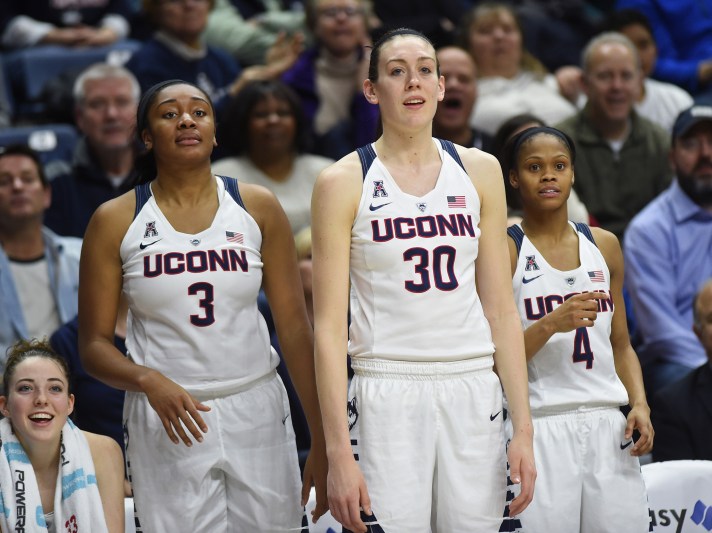Sports
A Website Went Offline And Took Most Of Women’s College Basketball Analytics With It – FiveThirtyEight

, at
By Ian Levy
Filed under March Madness
Brad Horrigan/Hartford Courant / TNS via Getty Images
If you’re filling out your bracket for the NCAA men’s basketball tournament and want some statistical background to the broader forecasts, you have a slew of options. Start at Sports-Reference.com: powerful search tools; team rankings for anything from pace to point differentials adjusted for strength of schedule; and player pages with stats such as usage percentage, win shares and Box Plus/Minus. Ken Pomeroy’s site offers more detailed and adjusted team rankings and a wide array of individual player metrics. For $100 a year, Shot Analytics delivers detailed spatial analysis of shot selection, including weighted shot charts.
If you’re looking for similar information to help you fill out an NCAA women’s basketball tournament bracket, you’re out of luck.
Last week, leading into the MIT Sloan Sports Analytics Conference, Sue Bird wrote a piece for The Players’ Tribune about this analytic gender gap, noting, “The disparity between NBA data — even data across all male sports — and WNBA data is glaring. Data for the WNBA is relegated to basic information: points, rebounds, steals, assists, turnovers, blocks. While worthy of being noted, those are the most rudimentary numbers in our game.” There are a few slightly richer sources of data for the women’s professional game — Basketball-Reference.com will let you see the true shooting percentage and usage rate for WNBA players, for example — but Bird’s overall characterization of the data disparity is dead-on, and the effect is even stronger in college basketball. That’s true this month more than most.
Until recently, the one repository for advanced statistics such as usage, true shooting percentage, pace-adjusted player statistics and adjusted team ratings for women’s college ball was WBBState.com, a vertical of data company National Statistical. But that source disappeared Feb. 29, when ServerAxis, the company that provided server space to National Statistical’s hosting company, suddenly took all its equipment offline. There are reports that ServerAxis was having financial problems, but the company has so far not responded to requests for comment. National Statistical also declined to comment on the situation on the advice of lawyers as it works to recover its data and bring the site back online.
Exactly how a web hosting company pulls up anchor, ditches its Miami headquarters, and ends up 1,300 miles away in Chicago, allegedly waiting for its servers to find their way home, is almost certainly a fascinating story, but it’s secondary to the reality that an entire sport’s advanced metrics wing can be wiped off the map by a few nerds absconding with a few hard drives and turning off their phones. This is a corollary to the more global lack of statistical interrogation of women’s basketball — the data isn’t just shallow, it’s scarce, and that scarcity makes it fragile.
What’s left behind is a patchwork collection of disparate scraps of data. ESPN has some statistics available for players and teams, but these cover only basic stats and are organized as leaderboards, so they can’t be searched or sorted beyond the top 50. You can find the full lists for most of those statistics, and a few others, on the NCAA’s website. It’s a thin statistical slice, and they are available for only the current season. Right now, if you wanted to find out where Breanna Stewart’s true shooting percentage ranked this season, or how many points per 100 possessions Baylor allowed, you’d need to scrape the data and calculate it yourself.
A paucity of data in any sport doesn’t just trim down the “analytics” branch — it fundamentally changes the types of stories that can be told about teams and athletes. “The more data you have,” says Howard Megdal, a contributing editor for the women’s sports site Excelle Sports, “the more you have the ability to parse it, and to compare it, and to do it more easily, the more stories that are out there.”
That’s no small point. In the landscape of women’s sports, college basketball in general and the NCAA Tournament in particular are enormously important. The nation’s attention has turned to college basketball, expecting rich, compelling and thorough analysis, and the women’s side, already handicapped by neglect, has lost one of its legs to a freak woodchipper accident. This leaves the writers who cover the tournament, missing servers be damned, in quite the lurch.
“The NCAA has the standard points and rebounds,” Megdal says, “but I’m writing today and trying to make the point that South Carolina’s offense is actually more efficient than its defense. You know people talk about South Carolina’s defense all the time. I only knew that because of WBBState, and being able to see the tempo-free stats. So when I went to go and prove it, I can’t right now; I can’t reference those numbers. All I can do is say that they’re 17th in points per game, or whatever. And as I’m doing it, I’m well aware that I’m using a highly flawed stat that doesn’t begin to capture what I’m after.”
In a way, that sums up the state of analytics in women’s basketball: Everyone knows that there are more powerful tools of observation waiting just out of reach, but there just isn’t much to do about it. Sometimes that’s because women’s leagues lack the financial might or institutional support to run in the lead pack; other times it’s because the wrong web host picked the wrong month to blow town.
Our sports podcast Hot Takedown previews March Madness.
Ian Levy is the senior NBA editor for FanSided.com and the man behind the curtain at The Step Back and Nylon Calculus. @HickoryHigh
Filed under
March Madness (225 posts) Women's College Basketball (73) 2016 NCAA Basketball Tournament (23)
© 2023 ABC News Internet Ventures. All rights reserved.









